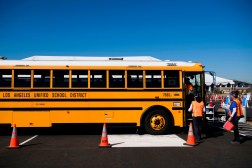Wi-Fi growth demands new solutions for schools

More students are using Wi-Fi than ever before thanks to technological advances in school — but how do administrators make sure their networks don’t get maxed out?
Schools actually face five challenges, according to Perry Correll, principal technologist at Xirrus, a 10-year-old Wi-Fi company based in Thousand Oaks, California. They include the increasing number and variety of devices that kids are using and bringing to school; prioritizing certain applications over others; upgrading to the next technology; guaranteeing and maintaining performance reliability; and doing all of that for less money.
“We have to design Wi-Fi correctly not just for today’s challenges, but what’s coming next,” Correll said during a webinar Wednesday, in which he detailed the common challenges schools face while managing a network, and then offered some Wi-Fi solutions. He said a lot is still unknown, like when schools will reach their Wi-Fi capacity and when the best time to upgrade may be.
“The first thing to understand is that Wi-Fi has changed — it used to cover as many areas as possible and then you can plug into a wired network,” Correll said. “That’s not the case anymore. There’s no Ethernet port on iPads. Wireless has become the primary connectivity method.”
In 2010, schools and businesses were designing their networks for coverage. Now, they are designing them for capacity. While five years ago there was one device per student, now there are two or three devices per pupil. In the past, Wi-Fi moved at slower speeds; today, it can operate on 5GHz.
One point Correll emphasized was not to follow the trendsetters all the time: “Just because new technology comes along doesn’t mean you have to spend a lot of money to upgrade your infrastructure,” he said. “In two or three years, we’ll see more improvements.”
He also said administrators need to understand different densities can accommodate different Wi-Fi speeds and capacities. A classroom can have 20 or 30 students on one access point, but the numbers shift if kids move to a cafeteria, gymnasium or football field. He added that Wi-Fi performance varies with distance, device, band and interference.
Laptops work on different speeds than smartphones on wireless networks, he cautioned. The smartphones can take up to 200 times longer than it takes to send the same information from a laptop, “which means the overall network performance is going to degrade,” he said. “If you have 50 devices connected to the same access point, chances are all those devices are connecting at a different rate based on capability, how far away they are from the access point and noise from the environment.”
For bring your own device programs, commonly referred to as BYOD, which are gaining popularity, Correll said it’s hard to tell what kids will bring in and use in class — “but that doesn’t mean you have to embrace chaos,” he added.
He said schools can enact policies to use certain brands over others, like choosing Apple products over Blackberry smartphones, or to allow children to use laptops or tablets but not phones or iPods. Once they connect, schools can then use filtering techniques to allow kids to go on social media apps like Twitter and Facebook only after a certain time. He said they can prioritize critical applications like online videos and edtech apps like Blackboard, and block applications like Dropbox and Instagram.
“It’s about optimizing user experience for all applications,” he said. “That’s the key point.”
Other pro tips include installing two access points in offices or isolated areas, four access points in classrooms and eight access points in lecture halls. To reduce costs, administrators should add technology as needed based on continual monitoring, and select network systems that offer the ability to upgrade, not just replace, networks.






